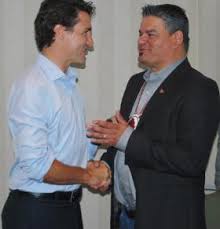By Jacqui Hebert
In 2012, Steven Harper’s Conservative government “streamlined” the Canadian Environmental Assessment Act (CEAA) to promote “responsible resource development”. Critics said the amendments created a “carte blanche” for big energy companies and put a stranglehold on public participation.
Under current Prime Minister Justin Trudeau, the Minister of Environment and Climate Change has been given the mandate to “immediately review Canada’s environmental assessment process to regain public trust”, to restore robust environmental oversight, and to increase opportunities for public participation, among other goals. An Expert Panel and a Multi-Interest Advisory Committee (MIAC) have been established and the review is underway; we may expect a new law within 2-3 years.
Underlying this review of Canadian environmental assessment law are Canada’s recent commitments to truth and reconciliation, “starting with the implementation of the United Nations Declaration on the Rights of Indigenous Peoples”. Crucially, Articles 19 and 32 the UNDRIP respectively require states to obtain free, prior, and informed consent (FPIC) before “adopting and implementing legislative […] measures that affect" Indigenous Peoples and before undertaking “any project affecting their lands or territories and other resources, particularly in connection with the development, utilization or exploitation of mineral, water or other resources”.
Though the incorporation of Indigenous perspectives has long been a key topic of conversation in Canadian environmental assessment, the time has come to take this issue one step further.
Crucially, First Nations have long asserted jurisdiction over the environment. The Musqueam Indian Band declared and affirmed their right to use and manage their title lands and resources by way of the 1976 Musqueam Declaration, on the basis of unextinguished aboriginal rights and title. The 1998 Tsilhqot’in Declaration of Sovereignty asserts jurisdiction over Indigenous territory and the environment as a function of pre-settler occupation and bestowal by the Creator of a responsibility to maintain and protect the land in accordance with natural law. More recently, the Saugeen Ojibway Nation have established an Environmental Office to assist the Chiefs and Councils of the Saugeen Ojibway Nations to assert First Nation jurisdiction over the environment of the traditional territories. Furthermore, the Kebaowek First Nation asserted Indigenous jurisdiction over environment in their very recent submission to the Parliamentary Expert Panel tasked with reviewing CEAA.

Prime Minister Justin Trudeau and Ontario Regional Chief Isadore Day
Notably, on June 23, 2016 the Ontario Regional Chief Isadore Day said that the recently launched review of the federal EA process will test the federal government’s recognition of First Nations jurisdiction over the environment. Specifically, Chief Day said that “the federal government’s recognition of First Nation environmental jurisdiction must be honoured before we can commit to any high level discussion at a Nation to Nation level” for fear of “more broken promises”.
Indigenous peoples generally agree that Indigenous jurisdiction over environment is derived from Indigenous laws and worldviews that predate settler contact. Indigenous legal scholar John Borrows articulates this point in his recent book “Freedom and Indigenous Constitutionalism”. To this end, part 45(iv) of the Truth and Reconciliation Commission’s Calls to Action requires the recognition of Indigenous laws and legal traditions. Further, articles 3, 4, and 5 of the UNDRIP recognize self-determination, self-government, and the right to Indigenous legal and political institutions, while articles 18 and 19 establish the right to Indigenous decision-making institutions and the right to consultation with those institutions. This being said, others who appeal to a colonial paradigm contend that Indigenous jurisdiction over environment flows instead from environmental rights recognized by section 35 of the Constitution Act, 1982 since these rights must include a related right to self-governance.
To move beyond basic consultation with Indigenous Peoples in Canadian EA toward a nation-to-nation procedure for joint decision-making, it will be crucial for the legislation to recognize inherent Indigenous jurisdiction, in light of Canada’s commitments to reconciliation and to the implementation of UNDRIP.
As such, a key question for environmental assessment reformers and the central question for my personal research project here at the Osgoode EJS clinic, is how next generation environmental assessment law should recognize Indigenous jurisdiction over the environment.
Environmental assessment law in Canada has long recognized shared environmental jurisdiction between the federal and provincial governments but has shifted from a policy of harmonized or cooperative assessment processes toward a policy of substitution and equivalency since the 2012 amendments. EA expert Meinhard Doelle describes substitution essentially as a preference for provincial EA processes upon provincial request where the Minister is satisfied that those processes “would be an appropriate substitution” for the federal regime. Doelle describes the more drastic equivalency option as an outright exemption of a project or a class of projects from the federal CEAA where provincial substitution has been approved.
With the review ongoing, there is impetus for a return to harmonization, specifically upward harmonization toward the “higher standard of assessment scope, criteria and process requirements wherever possible, with each jurisdiction actively engaged in the processes”. This is to be achieved via harmonization agreements that allow for “predictable sharing of EA responsibilities [and] efficient administration of the process among all affected levels of government and departments”.
Therefore, the most obvious way for next-generation EA to recognize indigenous jurisdiction is via nation-to-nation agreements for harmonization of federal and Indigenous approaches to EA processes.
Not only would this go some distance toward recognizing inherent Indigenous jurisdiction over the environment, it would also provide an impetus for First Nations to revitalize or develop their own legal frameworks for EA where such frameworks are missing or have fallen into disuse.
Nation-to-nation cooperation in federal environmental assessment is among the topics being discussed by the MIAC in reviewing CEAA 2012. If my research can reach their desk while the review is still ongoing, it may be capable of bringing this issue to the forefront of discussion on the implementation of multi-jurisdictional environmental assessment.


